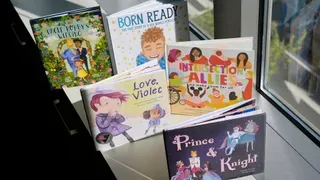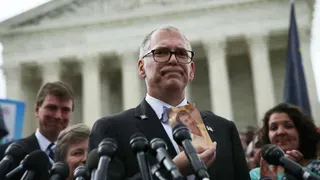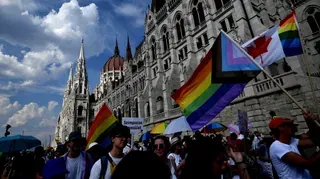April 30, 2012
Despite Popular Misconceptions, Lesbians Are At Risk for HIV
Shaun Knittel READ TIME: 5 MIN.
At age 29, Tonya Rasberry, a lesbian woman of color, learned she was HIV-positive. She contracted the virus from her late husband, the father of her three children.
"In the beginning, when I learned that I was positive, it seemed so surreal to me," Rasberry told EDGE. "I had an idea of the lifestyle my husband was leading but never did I stop and think that HIV would come into our lives."
"When Eric and I were together we shared a lot of things," she continued, "including partners."
"I was always attracted to women and of course I wasn't going to get a complaint out of him when it came to me living a bisexual lifestyle," she explained. "Not once did I consider the fact that maybe he also had a private life of his own, and no matter what we were doing behind closed doors neither one of us thought we would have HIV/AIDS affect our lives the way it has."
Eric died in October 2004.
"After my husband passed, I had come to accept the fact that I was going to live for a while and I wanted to start living my life for me and my children the way I wanted and with whom I truly wanted, on my terms," explained Rasberry. "I really wanted to embrace the fact that I am lesbian and I wanted to be with a woman. But dating was going to be something of a challenge because not only was I a single mother of three small children but I was going to have to disclose to my potential partner that I am HIV-positive."
Disclosure was something Rasberry never had to worry about during her marriage. She went online to consult the Centers for Disease Control and Prevention, to find out everything she could about transmission between two women. To her surprise, Rasberry said she came up pretty much empty handed.
"I will admit that made me happy at first because I was thinking 'Well if they don't have anything, maybe it was something that I didn't have to worry about -- maybe disclosing would be something I would never have to worry about,'" she said.
"Wrong," continued Rasberry. "Now that I'm a Peer Advocate at BABES Network YWCA in Seattle for women who have HIV/AIDS, I can see that type of information as being very misleading. And it could give the lesbian community and anyone else who was inquiring about transmission rates between two women a false sense of safety when it comes to HIV/AIDS and transmission."
According to Martin Salas, director of HIV Prevention Services and Health Education at AIDS Services Foundation Orange County, there is an insufficient amount of evidence-based interventions specifically designed for lesbians and bisexual women. Salas told EDGE the CDC use categories of exposure to HIV that apply to women that have sex primarily with women that may not reflect all of their risk factors.
"These categories are heterosexual contact with an HIV-positive partner, receipt of blood products, injection drug use, and no identified risk," said Salas. "As a result, these women are invisible in the categories of exposure to HIV, thus inaccurately reflecting risk factors for these women."
Salas asserts that women who have sex primarily with women are also not likely to disclose their sexual orientation to their doctor, making it even more difficult for reporting statistics.
"Consistency is the key to HIV prevention," Salas said. "This means using protection all the time, every time, even when you or your partner are under the influence."
Lack of Data Leads to False Sense of Protection
Rasberry says that the lack of facts about HIV/AIDS and the lesbian community did not surprise her because, "When it comes to getting some facts about women's health care we are almost always on the back burner so for women who identify as lesbians, their health concerns are really on the bottom of the totem pole."
Kim Chronister, M.A., who has worked as a therapist at AIDS Services Foundation, told EDGE that most women who have sex with women have been living under a false sense of protection with regard to their risk of being HIV infected.
Additionally, those who see themselves at risk rate their susceptibility as low. Despite the lack of adequate attempts to promote safer sex messages directed toward lesbians, the CDC has stated that there have been numerous documented cases of women who have sex with women and who have been infected.
"The first documented case of female-to-female transmission involved a woman in a monogamous same-sex relationship being infected by her partner," Chronister said. "In this case, the woman was infected due to 'rough sex' that was so rigorous it drew blood. Due to lesbians' misperceptions about their risk of HIV infection as well as the lack of adequate attempts to promote safer sex messages directed toward women who have sex with women, lesbians rarely take preventative steps."
Chronister told EDGE that her work as a therapist at the AIDS Services Foundation and the extensive research she has conducted in this area of HIV has "convinced me that although the risks are low, lesbians are still at risk as female-to-female transmission of HIV is possible."
"According to my research, HIV can potentially be transmitted by exposure of the mucous membrane (i.e., the mouth) to vaginal secretions," she said. "Also, shared penetrative toys may be a means for transmission of infected vaginal secretions, according to the CDC. In my therapeutic work with women who have sex with women, simple steps that these women can take to lower their risks of being infected may seem obvious, but unfortunately are rarely taken."
Rasberry says that some of these issues could be resolved through creating a better dialogue.
"I believe that just having the conversation about HIV/AIDS in our [lesbian] community is unbelievably crucial, because as long as a sexually active person is talking about those sensitive subjects it will help us alleviate some of the stigma that surrounds this topic," she said. "Within my circles I feel that sex, protected or not, is being talked about. Being an active peer supporter for eight years, I have learned that women love to talk about what's going on. Whether it's giving advice or receiving, they are talking."
The key, says Rasberry, who now has a loving partner who is HIV-negative, is maintaining a healthy and happy outlook on life.
"I have many friends that love me and support me, and who sometime say they forget that I'm HIV-positive because of my positive attitude. All I can really say is I won't let HIV change me," she said.
"I have HIV," concludes Rasberry. "HIV doesn't have me."
Shaun Knittel is an openly gay journalist and public affairs specialist living in Seattle. His work as a photographer, columnist, and reporter has appeared in newspapers and magazines throughout the Pacific Northwest. In addition to writing for EDGE, Knittel is the current Associate Editor for Seattle Gay News.







